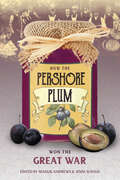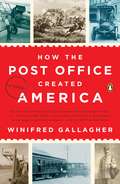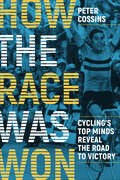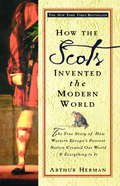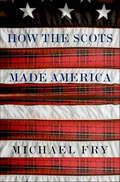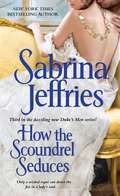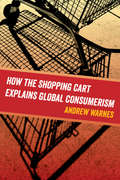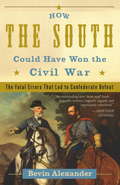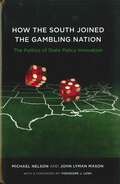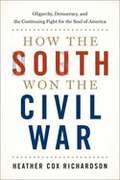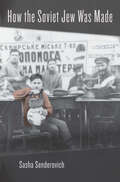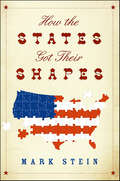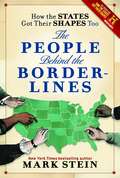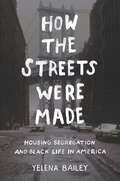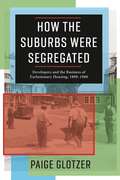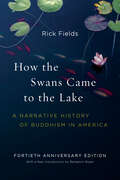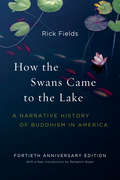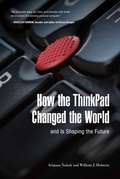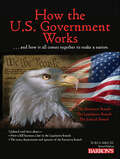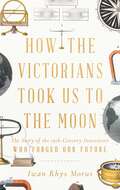- Table View
- List View
How the Pershore Plum Won the Great War
by Maggie Andrews Jenni WaughThe First World War was won not just on the battlefields but on the Home Front, by the men, women and children left behind. This book explores the lives of the people of Pershore and the surrounding district in wartime, drawing on their memories, letters, postcards, photographs, leaflets and recipes to demonstrate how their hard work in cultivating and preserving fruit and vegetables helped to win the Great War. Pershore plums were used to make jam for the troops; but ensuring these and other fruits and vegetables were grown and harvested required the labour of land girls, Boy Scouts, schoolchildren, Irish labourers and Belgian refugees. When submarine warfare intensified, food shortages occurred and it became vital for Britain to grow more and eat less food. Housewives faced many challenges in feeding their families and so in 1916 the Pershore Women’s Institute was formed, providing many women with practical help and companionship during some of Britain’s darkest hours in history.
How the Pilgrims Came to Plymouth
by Olga W. Hall-QuestA historic account of the Pilgrims' landing at Plymouth.
How the Post Office Created America: A History
by Winifred GallagherA masterful history of a long underappreciated institution, How the Post Office Created America examines the surprising role of the postal service in our nation's political, social, economic, and physical development. The founders established the post office before they had even signed the Declaration of Independence, and for a very long time, it was the U.S. government's largest and most important endeavor--indeed, it was the government for most citizens. This was no conventional mail network but the central nervous system of the new body politic, designed to bind thirteen quarrelsome colonies into the United States by delivering news about public affairs to every citizen--a radical idea that appalled Europe's great powers. America's uniquely democratic post powerfully shaped its lively, argumentative culture of uncensored ideas and opinions and made it the world's information and communications superpower with astonishing speed. Winifred Gallagher presents the history of the post office as America's own story, told from a fresh perspective over more than two centuries. The mandate to deliver the mail--then "the media"--imposed the federal footprint on vast, often contested parts of the continent and transformed a wilderness into a social landscape of post roads and villages centered on post offices. The post was the catalyst of the nation's transportation grid, from the stagecoach lines to the airlines, and the lifeline of the great migration from the Atlantic to the Pacific. It enabled America to shift from an agrarian to an industrial economy and to develop the publishing industry, the consumer culture, and the political party system. Still one of the country's two major civilian employers, the post was the first to hire women, African Americans, and other minorities for positions in public life. Starved by two world wars and the Great Depression, confronted with the country's increasingly anti-institutional mind-set, and struggling with its doubled mail volume, the post stumbled badly in the turbulent 1960s. Distracted by the ensuing modernization of its traditional services, however, it failed to transition from paper mail to email, which prescient observers saw as its logical next step. Now the post office is at a crossroads. Before deciding its future, Americans should understand what this grand yet overlooked institution has accomplished since 1775 and consider what it should and could contribute in the twenty-first century.Gallagher argues that now, more than ever before, the imperiled post office deserves this effort, because just as the founders anticipated, it created forward-looking, communication-oriented, idea-driven America.From the Hardcover edition.
How the RAF & USAAF Beat the Luftwaffe
by Ken Delve"The Luftwaffe had to be used in a decisive way in the Battle of Britain as a means of conducting total air war. Its size, technical equipment and the means at its disposal precluded the Luftwaffe from fulfilling this mission." - Adolf Galland How did the RAF beat the Luftwaffe during the Second World War? Was it actually the fact that they did not lose which later enabled them to claim victory – a victory that would have been impossible without the participation of the Americans from early 1943? This groundbreaking study looks at the main campaigns in which the RAF – and later the Allies – faced the Luftwaffe. Critically acclaimed writer Ken Delve argues that by the latter part of 1942 the Luftwaffe was no longer a decisive strategic or even tactical weapon. The Luftwaffe was remarkably resilient, but it was on a continual slide to ultimate destruction. Its demise is deconstructed according to defective strategic planning from the inception of the Luftwaffe; its failure to provide decisive results over Britain in 1940 and over the Mediterranean and Desert in 1941–1942; and its failure to defend the Reich and the occupied countries against the RAF and, later, combined Allied bomber offensive. Delve studies numerous aspects to these failures, from equipment (aircraft and weapons) to tactics, leadership (political and military), logistics, morale and others.
How the Race Was Won: Cycling's Top Minds Reveal the Road to Victory
by Peter CossinsGreat cyclists are born, but winning cyclists are made by the brains of their managers. The craft of racing requires a non-stop obsession with detail: watching rivals, judging the strength of a break, knowing the course, and picking the right moment to seize a fleeting opportunity and turn it into a big win.How the Race Was Won investigates the fine details of bicycle racing through extensive interviews with the sport’s brightest minds. Author Peter Cossins has interrogated the riders, managers, and directors who have shaped the sport, and reveals how they learned to navigate the invisible undercurrent that sweeps their riders to the finish line.From the moment when George Pilkington Mills was paced to victory by a wily teammate in the 1891 edition of Bordeaux–Paris to Chris Froome’s modern emphasis on marginal gains, How the Race Was Won embraces the full sweep of cycling history, making stops along the way to analyze how tactics first evolved and how today’s winning minds continue to build on what came before.Behind every great cyclist is a race wizard reading the race, watching the rivals, outwitting the competition, and anticipating the one perfect moment to launch a rider to victory. How the Race Was Won is a thrilling and unprecedented look at how victory is won, how rivals are vanquished, and how pure speed can only prevail when supported by deep brainpower.
How the Scots Invented the Modern World: The True Story of How Western Europe's Poorest Nation Created Our World and Everything in It
by Arthur HermanWho formed the first modern nation? Who created the first literate society? Who invented our modern ideas of democracy and free market capitalism? The Scots. Mention of Scotland and the Scots usually conjures up images of kilts, bagpipes, Scotch whiskey, and golf. But as historian and author Arthur Herman demonstrates, in the eighteenth and nineteenth centuries Scotland earned the respect of the rest of the world for its crucial contributions to science, philosophy, literature, education, medicine, commerce, and politics--contributions that have formed and nurtured the modern West ever since. Arthur Herman has charted a fascinating journey across the centuries of Scottish history. He lucidly summarizes the ideas, discoveries, and achievements that made this small country facing on the North Atlantic an inspiration and driving force in world history. Here is the untold story of how John Knox and the Church of Scotland laid the foundation for our modern idea of democracy; how the Scottish Enlightenment helped to inspire both the American Revolution and the U. S. Constitution; and how thousands of Scottish immigrants left their homes to create the American frontier, the Australian outback, and the British Empire in India and Hong Kong. How the Scots Invented the Modern World reveals how Scottish genius for creating the basic ideas and institutions of modern life stamped the lives of a series of remarkable historical figures, from James Watt and Adam Smith to Andrew Carnegie and Arthur Conan Doyle, and how Scottish heroes continue to inspire our contemporary culture, from William "Braveheart" Wallace to James Bond. Victorian historian John Anthony Froude once proclaimed, "No people so few in number have scored so deep a mark in the world's history as the Scots have done. " And no one who has taken this incredible historical trek, from the Highland glens and the factories and slums of Glasgow to the California Gold Rush and the search for the source of the Nile, will ever view Scotland and the Scots--or the modern West--in the same way again. For this is a story not just about Scotland: it is an exciting account of the origins of the modern world and its consequences. "The point of this book is that being Scottish turns out to be more than just a matter of nationality or place of origin or clan or even culture. It is also a state of mind, a way of viewing the world and our place in it. . . . This is the story of how the Scots created the basic idea of modernity. It will show how that idea transformed their own culture and society in the eighteenth century, and how they carried it with them wherever they went. Obviously, the Scots did not do everything by themselves: other nations--Germans, French, English, Italians, Russians, and many others--have their place in the making of the modern world. But it is the Scots more than anyone else who have created the lens through which we see the final product. When we gaze out on a contemporary world shaped by technology, capitalism, and modern democracy, and struggle to find our place as individuals in it, we are in effect viewing the world as the Scots did. . . . The story of Scotland in the eighteenth and nineteenth centuries is one of hard-earned triumph and heart-rending tragedy, spilled blood and ruined lives, as well as of great achievement. " --FROM THE PREFACE From the Hardcover edition.
How the Scots Made America
by Michael FryEver since they first set foot in the new world alongside the Viking explorers, the Scots have left their mark. In this entertaining and informative book, historian Michael Fry shows how Americans of Scottish heritage helped shape this country, from its founding days to the present. They were courageous pioneers, history-changing revolutionaries, great Presidents, doughty fighters, inspiring writers, learned teachers, intrepid explorers, daring frontiersmen, and of course buccaneering businessmen, media moguls, and capitalists throughout American history. The Scots' unflappable spirit and hardy disposition helped them take root among the earliest settlements and become some of the British colonies' foremost traders. During the Revolution, the teachings of the great Scottish philosophers and economists would help to shape the democracy that thrived in America as in no other part of the world. America may have separated from the British Empire, but the Scottish influence on the young continent never left.Armed with an inimitable range of historical knowledge, Fry charts the exchange of ideas and values between Scotland and America that led to many of the greatest achievements in business, science, and the arts. Finally, he takes readers into the twentieth century, in which the Scots serve as the ideal example of a people that have embraced globalization without losing their sense of history, culture and national identity.Scottish Americans have been incomparable innovators in every branch of American society, and their fascinating story is brilliantly captured in this new book by one of Scotland's leading historians. How the Scots Made America is not only a must-read for all those with Scottish ancestry but for anyone interested in knowing the full story behind the roots of the American way of life.
How the Scoundrel Seduces (The Duke's Men #3)
by Sabrina JeffriesThe third deliciously sexy novel in the New York Times bestselling Duke’s Men historical romance series, featuring an investigator who sets out to find gypsies—and unexpectedly finds love.Investigator Tristan Baonnaud has one aim in life—to make sure that his half-brother George can&’t ever ruin his life again. So when the pesky Lady Zoe Keane, the daughter of the Earl of Olivier, shows up demanding that the Duke&’s Men find a mysterious gypsy woman, he seizes the opportunity to also hunt for a gypsy friend who knows secrets about George. Tristan doesn&’t expect to uncover Lady Zoe&’s family secrets, as well…or end up falling for the woman who will risk all to discover the truth.
How the Shopping Cart Explains Global Consumerism
by Andrew WarnesPicture a familiar scene: long lines of shoppers waiting to check out at the grocery store, carts filled to the brim with the week’s food. While many might wonder what is in each cart, Andrew Warnes implores us to consider the symbolism of the cart itself. In his inventive new book, Warnes examines how the everyday shopping cart is connected to a complex web of food production and consumption that has spread from the United States throughout the world. Today, shopping carts represent choice and autonomy for consumers, a recognizable American way of life that has become a global phenomenon. This succinct and and accessible book provides an excellent overview of consumerism and the globalization of American culture.
How the South Could Have Won the Civil War: The Fatal Errors That Led to Confederate Defeat
by Bevin AlexanderAlexander posits the idea that the South could have won the Civil War given some tactical and strategic changes and better communication among the generals, rather than differing views about how to fight the war. He discusses how Jefferson Davis, Robert E. Lee, and Thomas "Stonewall" Jackson disagreed on strategy, the turning point battle that was never necessary, how the Confederate army never implemented its strategy to negate the Union's advantages in manpower and weaponry, how Abraham Lincoln saw the Union's problems better than the Confederacy's leaders, and how the South failed to learn from the lessons of its 1863 victory at Chancellorsville. Among the battles examined are those at Fredericksburg, Antietam, Gettsyburg, and Appomattox. Alexander is the author several books on military history, including Lost Victories. Annotation ©2008 Book News, Inc. , Portland, OR (booknews. com)
How the South Joined the Gambling Nation: The Politics of State Policy Innovation
by Michael Nelson Theodore J. Lowi John Lyman MasonA national map of legalized gambling from 1963 would show one state, Nevada, with casino gambling and no states with lotteries. Today's map shows eleven commercial casino states, most of them along the Mississippi River, forty-two states with state-owned lotteries, and racetrack betting, slot-machine parlors, charitable bingo, and Native American gambling halls flourishing throughout the nation. For the past twenty years, the South has wrestled with gambling issues. In How the South Joined the Gambling Nation, Michael Nelson and John Lyman Mason examine how modern southern state governments have decided whether to adopt or prohibit casinos and lotteries. Nelson and Mason point out that although the South participated fully in past gambling eras, it is the last region to join the modern movement embracing legalized gambling. Despite the prevalence of wistful, romantic images of gambling on southern riverboats, the politically and religiously conservative ideology of the modern South makes it difficult for states to toss their chips into the pot.The authors tell the story of the arrival or rejection of legalized gambling in seven southern states -- Mississippi, Louisiana, Tennessee, South Carolina, Georgia, Arkansas, and Alabama. The authors suggest that some states chose to legalize gambling based on the examples of other nearby states, as when Mississippi casinos spurred casino legalization in Louisiana and the Georgia lottery inspired lottery campaigns in neighboring South Carolina, Alabama, and Tennessee. Also important was the influence of Democratic policy entrepreneurs, such as Zell Miller in Georgia, Don Siegelman in Alabama, and Edwin Edwards in Louisiana, who wanted to sell the idea of gambling in order to sell themselves to voters. At the same time, each state had its own idiosyncrasies, such as certain provisions of their state constitutions weighing heavily as a factor.Nelson and Mason show that the story of gambling's spread in the South exemplifies the process of state policy innovation. In exploring how southern states have weighed the moral and economic risk of legalizing gambling, especially the political controversies that surround these discussions, Nelson and Mason employ a suspenseful, fast-paced narrative that echoes the oftentimes hurried decisions made by state legislators. Although each of these seven states fought a unique battle over gambling, taken together, these case studies help tell the larger story of how the South -- sometimes reluctantly, sometimes enthusiastically -- decided to join the gambling nation.
How the South Won the Civil War: Oligarchy, Democracy, and the Continuing Fight for the Soul of America
by Heather Cox RichardsonThis book is named one of The Washington Post's 50 Notable Works of Nonfiction. Heather Cox Richardson argues in this provocative work that democracy's blood-soaked victory was ephemeral. The system that had sustained the defeated South moved westward and there established a foothold. It was a natural fit. Settlers from the East had for decades been pushing into the West, where the seizure of Mexican lands at the end of the Mexican-American War and treatment of Native Americans cemented racial hierarchies. The South and West equally depended on extractive industries-cotton in the former and mining, cattle, and oil in the latter-giving rise a new birth of white male oligarchy, despite the guarantees provided by the 13th, 14th, and 15th Amendments, and the economic opportunities afforded by expansion. To reveal why this happened, How the South Won the Civil War traces the story of the American paradox, the competing claims of equality and subordination woven into the nation's fabric and identity.
How the Soviet Jew Was Made
by Sasha SenderovichA close reading of postrevolutionary Russian and Yiddish literature and film recasts the Soviet Jew as a novel cultural figure: not just a minority but an ambivalent character navigating between the Jewish past and Bolshevik modernity.The Russian Revolution of 1917 transformed the Jewish community of the former tsarist empire. In particular, the Bolshevik government eliminated the requirement that most Jews reside in the Pale of Settlement in what had been Russia’s western borderlands. Many Jews quickly exited the shtetls, seeking prospects elsewhere. Some left for bigger cities, others for Europe, America, or Palestine. Thousands tried their luck in the newly established Jewish Autonomous Region in the Far East, where urban merchants would become tillers of the soil. For these Jews, Soviet modernity meant freedom, the possibility of the new, and the pressure to discard old ways of life.This ambivalence was embodied in the Soviet Jew—not just a descriptive demographic term but a novel cultural figure. In insightful readings of Yiddish and Russian literature, films, and reportage, Sasha Senderovich finds characters traversing space and history and carrying with them the dislodged practices and archetypes of a lost Jewish world. There is the Siberian settler of Viktor Fink’s Jews in the Taiga, the folkloric trickster of Isaac Babel, and the fragmented, bickering family of Moyshe Kulbak’s The Zemlenyaners, whose insular lives are disrupted by the march of technological, political, and social change. There is the collector of ethnographic tidbits, the pogrom survivor, the émigré who repatriates to the USSR.Senderovich urges us to see the Soviet Jew anew, as not only a minority but also a particular kind of liminal being. How the Soviet Jew Was Made emerges as a profound meditation on culture and identity in a shifting landscape.
How the Sphinx Got to the Museum (How The ... Got To The Museum)
by Jessie HartlandDepicts how the Sphinx was commissioned by the Pharaoh, was built, was rediscovered after centuries and then travelled to New York.
How the States Got Their Shapes
by Mark SteinNew York Times Bestseller"Give me the splendid irregularities any day. God bless the panhandles and notches, the West Virginias and Oklahomas." -- Wall Street JournalWhy does Oklahoma have that panhandle? Did someone make a mistake? We are so familiar with the map of the United States that our state borders seem as much a part of nature as mountains and rivers. Even the oddities—the entire state of Maryland(!)—have become so ingrained that our map might as well be a giant jigsaw puzzle designed by Divine Providence. How the States Got Their Shapes is the first book to tackle why our state lines are where they are. Here are the stories behind the stories, right down to the tiny northward jog at the eastern end of Tennessee and the teeny-tiny (and little known) parts of Delaware that are not attached to Delaware but to New Jersey. Packed with fun oddities and trivia, this entertaining guide also reveals the major fault lines of American history, from ideological intrigues and religious intolerance to major territorial acquisitions. Adding the fresh lens of local geographic disputes, military skirmishes, and land grabs, Mark Stein shows how the seemingly haphazard puzzle pieces of our nation fit together perfectly.
How the States Got Their Shapes Too: The People Behind the Borderlines
by Mark SteinWas Roger Williams too pure for the Puritans, and what does that have to do with Rhode Island? Why did Augustine Herman take ten years to complete the map that established Delaware? How did Rocky Mountain rogues help create the state of Colorado? All this and more is explained in Mark Stein's new book.How the States Got Their Shapes Too follows How the States Got Their Shapes looks at American history through the lens of its borders, but, while How The States Got Their Shapes told us why, this book tells us who. This personal element in the boundary stories reveals how we today are like those who came before us, and how we differ, and most significantly: how their collective stories reveal not only an historical arc but, as importantly, the often overlooked human dimension in that arc that leads to the nation we are today.The people featured in How the States Got Their Shapes Too lived from the colonial era right up to the present. They include African Americans, Native Americans, Hispanics, women, and of course, white men. Some are famous, such as Thomas Jefferson, John Quincy Adams, and Daniel Webster. Some are not, such as Bernard Berry, Clarina Nichols, and Robert Steele. And some are names many of us know but don't really know exactly what they did, such as Ethan Allen (who never made furniture, though he burned a good deal of it).In addition, How the States Got Their Shapes Too tells of individuals involved in the Almost States of America, places we sought to include but ultimately did not: Canada, the rest of Mexico (we did get half), Cuba, and, still an issue, Puerto Rico. Each chapter is largely driven by voices from the time, in the form of excerpts from congressional debates, newspapers, magazines, personal letters, and diaries. Told in Mark Stein's humorous voice, How the States Got Their Shapes Too is a historical journey unlike any other you've taken. The strangers you meet here had more on their minds than simple state lines, and this book makes for a great new way of seeing and understanding the United States.From the Hardcover edition.
How the Streets Were Made: Housing Segregation and Black Life in America
by Yelena BaileyIn this book, Yelena Bailey examines the creation of "the streets" not just as a physical, racialized space produced by segregationist policies but also as a sociocultural entity that has influenced our understanding of blackness in America for decades. Drawing from fields such as media studies, literary studies, history, sociology, film studies, and music studies, this book engages in an interdisciplinary analysis of the how the streets have shaped contemporary perceptions of black identity, community, violence, spending habits, and belonging. Where historical and sociological research has examined these realities regarding economic and social disparities, this book analyzes the streets through the lens of marketing campaigns, literature, hip-hop, film, and television in order to better understand the cultural meanings associated with the streets. Because these media represent a terrain of cultural contestation, they illustrate the way the meaning of the streets has been shaped by both the white and black imaginaries as well as how they have served as a site of self-assertion and determination for black communities.
How the Suburbs Were Segregated: Developers and the Business of Exclusionary Housing, 1890–1960 (Columbia Studies in the History of U.S. Capitalism)
by Paige GlotzerThe story of the rise of the segregated suburb often begins during the New Deal and the Second World War, when sweeping federal policies hollowed out cities, pushed rapid suburbanization, and created a white homeowner class intent on defending racial barriers. Paige Glotzer offers a new understanding of the deeper roots of suburban segregation. The mid-twentieth-century policies that favored exclusionary housing were not simply the inevitable result of popular and elite prejudice, she reveals, but the culmination of a long-term effort by developers to use racism to structure suburban real estate markets.Glotzer charts how the real estate industry shaped residential segregation, from the emergence of large-scale suburban development in the 1890s to the postwar housing boom. Focusing on the Roland Park Company as it developed Baltimore’s wealthiest, whitest neighborhoods, she follows the money that financed early segregated suburbs, including the role of transnational capital, mostly British, in the U.S. housing market. She also scrutinizes the business practices of real estate developers, from vetting homebuyers to negotiating with municipal governments for services. She examines how they sold the idea of the suburbs to consumers and analyzes their influence in shaping local and federal housing policies. Glotzer then details how Baltimore’s experience informed the creation of a national real estate industry with professional organizations that lobbied for planned segregated suburbs. How the Suburbs Were Segregated sheds new light on the power of real estate developers in shaping the origins and mechanisms of a housing market in which racial exclusion and profit are still inextricably intertwined.
How the Swans Came to the Lake: A Narrative History of Buddhism in America
by Rick Fields Benjamin BoginThis new updated edition of How the Swans Came to the Lake includes much new information about recent events in Buddhist groups in America and discusses such issues as spiritual authority, the role of women, and social action.
How the Swans Came to the Lake: A Narrative History of Buddhism in America
by Rick FieldsThis new updated edition of How the Swans Came to the Lake includes much new information about recent events in Buddhist groups in America and discusses such issues as spiritual authority, the role of women, and social action.
How the ThinkPad Changed the World—and Is Shaping the Future
by William Holstein Arimasa NaitohThe ThinkPad notebook computer has been at the center of the digital revolution that has transformed millions of lives around the world, allowing users to obtain access to their documents, pictures and other personal data from virtually anywhere at any time. More than 100 million ThinkPads have been sold since they were introduced in 1992, some twenty-five years ago. ThinkPads played a prominent role in NASA's space exploration and at the International Space Station. They accompanied explorers who traversed the entire length of the Nile River and conquered Mount Everest. ThinkPads also played a major role in changing the very architecture of how humanity's knowledge is stored and made available.In this book, Arimasa Naitoh, the father of the ThinkPad, collaborates with American business journalist and author William J. Holstein to write candidly about the incredible technological and personal struggles he and fellow engineers faced. And he offers his vision of the future of mobile computing—because this revolution is not even close to being finished.
How the U.S. Government Works: ...and how it all comes together to make a nation
by Syl Sobel J.D.This updated, easy-to-read book about the United States for kids explains the federal system as it works today. It also discusses why the framers of the Constitution created the U.S. government in the 18th century and the purposes it was designed to serve.Parents, teachers, and gift givers will find:an easy-to-read book about a complex subject revised for the classroom and homecurriculum aligned vocabulary, expanded glossary, discussion questions, and resource guideinformation on how presidents and other officials are elected or appointedDescribed are the Legislative branch, composed of the Senate and the House of Representatives; the Executive branch, headed by the President with the Cabinet members; and the Judicial branch, comprised of the Supreme Court of the United States and the lower federal courts throughout the nation.
How the U.S. Government Works: A Kid's Guide to Civics
by Syl Sobel J.D.Newly updated edition!Discover everything you need to know about American democracy with this easy-to-read guide to our government!How the U.S. Government Works is a fact-packed primer that helps kids understand the many facets of America's federal system. Readers will learn about how the government came to be, the responsibilities of the Executive, Legislative, and Judicial branches, and how our democracy impacts their own lives today!
How the Vertebrate Brain Regulates Behavior: Direct from the Lab
by Donald PfaffThroughout his career, Donald Pfaff has demonstrated that by choosing problems and methods with care, biologists can study the molecular mechanisms of brains more complex than those of fruit flies, snails, and roundworms. He offers a close-up, conversational perspective on a 50-year quest to understand how behavior is regulated in vertebrates.
How the Victorians Took Us to the Moon: The Story of the 19th-Century Innovators Who Forged Our Future
by Iwan Rhys MorusThe rich and fascinating history of the scientific revolution of the Victorian Era, leading to transformative advances in the twentieth and twenty-first centuries.The Victorians invented the idea of the future. They saw it as an undiscovered country, one ripe for exploration and colonization. And to get us there, they created a new way of ordering and transforming nature, built on grand designs and the mass-mobilization of the resources of the British Empire. With their expert culture of accuracy and precision, they created telegraphs and telephones, electric trams and railways, built machines that could think, and devised engines that could reach for the skies. When Cyrus Field&’s audacious plan to lay a telegraph cable across the Atlantic finally succeeded in 1866, it showed how science, properly disciplined, could make new worlds. As crowds flocked to the Great Exhibition of 1851 and the exhibitions its success inaugurated, they came to see the future made fact—to see the future being built before their eyes. In this rich and absorbing book, a distinguished historian of science tells the story of how this future was made. From Charles Babbage&’s dream of mechanizing mathematics to Isambard Kingdom Brunel&’s tunnel beneath the Thames to George&’s Cayley&’s fantasies of powered flight and Nikola Tesla&’s visions of an electrical world, it is a story of towering personalities, clashing ambitions, furious rivalries and conflicting cultures—a rich tapestry of remarkable lives that transformed the world beyond recognition and ultimately took mankind to the Moon
